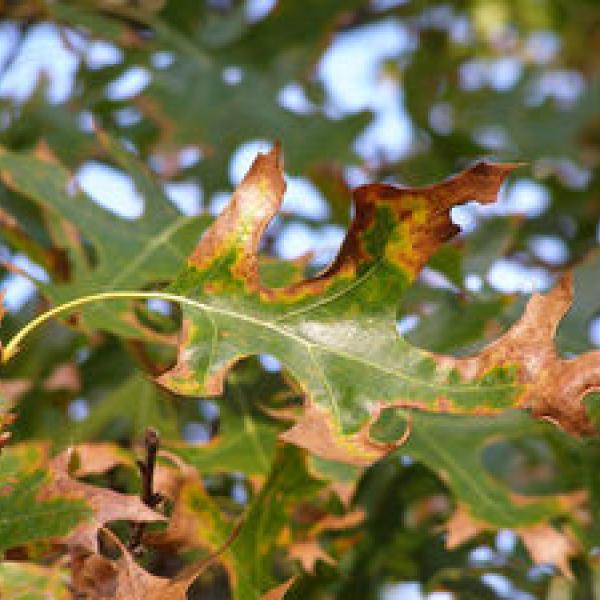
By Jan Beglinger Genesee Master Gardener
Oak wilt is an aggressive and often deadly disease that affects all species of oaks (Quercus). It is one of the most serious tree diseases in the eastern United States.
Each year thousands of oaks die from this disease in yards, public landscapes and forests. It has been found in 21 states, with considerable damage occurring in the Midwest.
Currently there are no known infestations of oak wilt in New York. In 2008 a small outbreak was discovered in Schenectady County and thought to be eradicated, but additional infected trees were found in 2013. In order to search the state for this disease, the Cornell Plant Disease Diagnostic Clinic (PDDC) is collaborating with the NYS Department of Environmental Conservation and the NYS Department of Agriculture and Markets. If oak wilt is present in the state, we need to locate it so it can be eradicated.
Oak wilt is caused by the fungus Ceratocystis fagacearum. It was first identified in 1944 by forest pathologists in Wisconsin. The fungus grows in the water-conducting vessels (xylem) of infected oak trees. It causes the xylem to produce gummy plugs which prevent water from being transported, killing the tree.
Oak wilt fungus only attacks oak trees. All species of oaks are susceptible, but resistance varies among oak species. The most susceptible are those in the red oak group (pointed lobes on their leaves). Northern red and pin oaks can die within a few weeks of infection. Bur oaks may die within one to three years of infection. White oaks are the most resistant and may survive for years after infection, even while displaying symptoms.
Oak wilt disease symptoms progress faster in red oaks than white oaks, but the symptoms are typical of other types of wilts. Leaves usually begin withering in the upper canopy, with whole branches turning brown. Red oak leaves look “scorched”, showing yellowing and browning of the leaf margins. Leaves begin to drop soon after symptoms first develop. In some oak species, brown streaks develop in the outer sapwood of infected branches when leaf symptoms appear. White oaks usually die slowly, one branch at a time, over a period of one to many years.
The oak wilt fungus can be spread through underground root grafts between oak trees or by sap feeding beetles in the Nitidulidae family. The year after defoliation, fungus or spore mats may form on the trunk under the bark. Mats are primarily formed on red oaks. Mats are oval and gray or tan in color turning black with age. They develop pressure pads that push out and crack the bark, exposing the fungus. Mycelial mats give off a rotting fruit smell which attracts the sap feeding beetles. The beetles pick up the spores as they crawl on the mats. The contaminated beetles then carry the spores to open wounds on healthy oak trees.
Oak wilt can also be spread long distances through the movement of infected firewood. If you decide to use a dead oak tree (that has oak wilt) for firewood, the diseased wood should be burned that winter. Trees with bark firmly attached may still produce or harbor fungal mats which could produce spores the following spring. Firewood that has been debarked is not a source of infection. Once the bark becomes loose or falls off, mats cannot be produced. The fungus is very temperature sensitive and does not survive being dried out.
The best control measure is prevention. Diseased trees should be removed from the landscape as soon as possible. Avoid pruning healthy trees during the infection period, generally April through July. This is when most sap beetles fly to locate fresh sap from tree wounds. If pruning is necessary during the growing season, cover the wounds. This can be done with a tree wound paint or latex paint. Although this will slow the wound healing, it will also discourage beetles from landing on the fresh wounds.
Stopping direct tree-to-tree transmission is important. Interrupting the disease cycle is accomplished by physically severing root contacts between diseased and healthy trees. Vibratory plows or backhoes can be used to break root grafts by creating a trench around trees. This severs the roots which prevents the spread through the grafts.
Once a red oak tree is infected with oak wilt there is no known chemical treatment that can cure the disease. Fungicides are suggested only for high value trees that are in danger of being infected. According to Ohio State University, the only scientifically tested systemic fungicide showing any efficacy and labeled for use against oak wilt is propiconazole. It is most effective when applied as a preventative treatment. Oak trees would need re-treatment every one to three years depending on their size and value in the landscape.
There are other factors such as drought, insects or other diseases that can cause similar symptoms to oak wilt. A conclusive diagnosis can only be made in specialized laboratories such as the Cornell PDDC.
Help stop this potentially devastating disease. If you have an oak tree that you suspect may have oak wilt, email the DEC Forest Health office at foresthealth@dec.ny.gov or call 1-866-640-0652. Samples from suspect trees may also be submitted to the Cornell PDDC by individuals. Prior to collecting and shipping samples, good digital photos showing the overall symptoms on the tree(s) and the symptoms on individual leaves should be submitted. Full instructions for submitting samples to the Cornell PDDC can be found online at http://plantclinic.cornell.edu/oaktwilt/oakwiltinstructions.pdf.
Resources for this article include: Cornell University, NYS DEC, USDA Forest Service, Ohio State University, NYS Invasive Species Information, University of Wisconsin and University of Illinois.